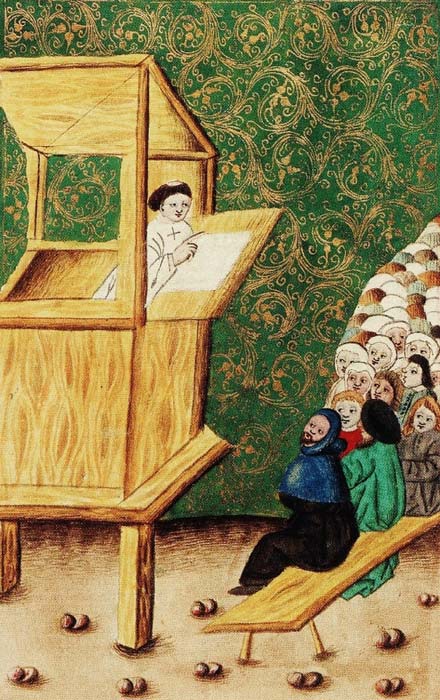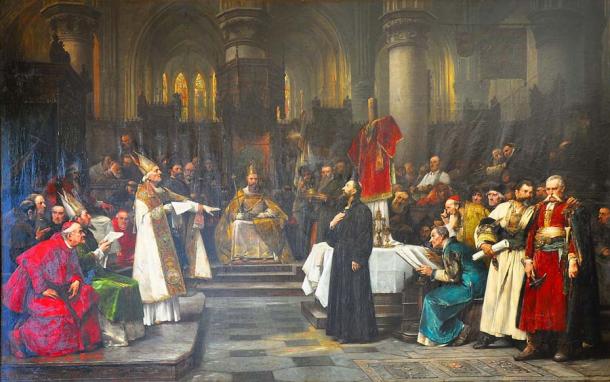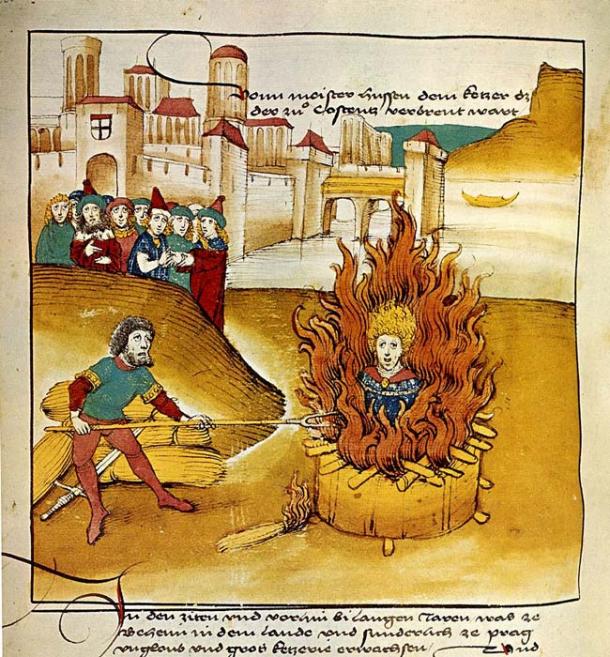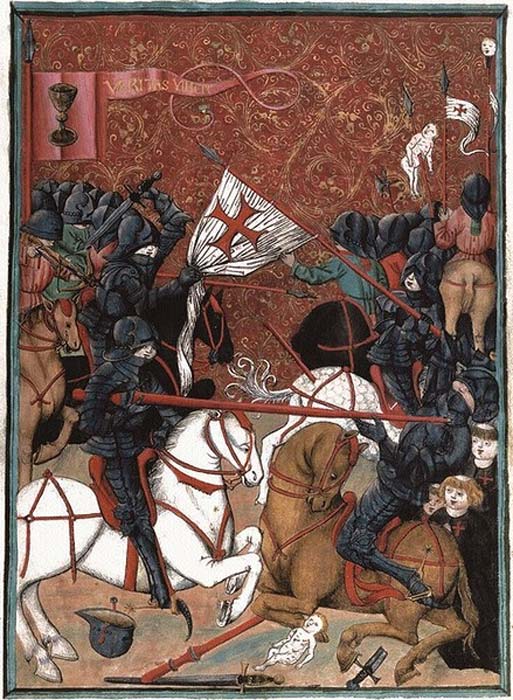The Hussites were members of a pre-Reformation Christian movement that originated in Bohemia, in the modern-day Czech Republic. Named after Jan Hus, whose teachings were followed by the Hussite movement, they opposed many of the tenets of the Roman Catholic Church in the hope of reformation. Denounced as heretics, relations between Hussites and Catholics became increasingly tense, and ultimately led to the break out of the Hussite Wars in 1419.

The ideas and writings of John Wycliffe (left), an English religious reformer, had a huge impact on the beliefs of Jan Hus (right). In turn these inspired the Hussite movement. Both images from the Nuremberg Chronicle. (Left: Public domain / Right: Public domain )
Precursor to the Hussite Wars: Jan Hus and the Writings of John Wycliffe
The story of the Hussites begins with the figure of Jan Hus, a Christian reformer who preceded Martin Luther by about a century. Born around 1370 in Husinec, southern Bohemia (now in the Czech Republic), little is known about Hus’ family, save that they were poor. It may be added that Hus’ surname was taken from his place of birth. At a young age, Hus left his hometown for Prague, where he earned his living by singing and serving in the churches.
Around 1390, Hus began his studies at the University of Prague. He graduated in 1393/4, and in 1396 received his master’s degree, after which he began teaching at his alma mater. In 1400, Hus was ordained a priest, and subsequently became confessor to the queen of Bohemia. In the following year, Hus became the dean of the philosophy faculty at the University of Prague. In 1402, Hus was appointed rector of the university.
In 1401 the writings of John Wycliffe, an English religious reformer, were brought to Prague. Hus was heavily influenced by Wycliffe’s underling principles, though he rejected their extreme implications. In any case, Hus was particularly attracted to Wycliffe’s call to reform the clergy. This is demonstrated in the fact that Hus began to speak out against the clergy’s lack of morality from the pulpit.
Hus even helped to spread Wycliffe’s teachings in Prague by translating one of his works, Trialogus, into Czech, and having it distributed. Initially, Hus received the support of Zybnek Zajic, the archbishop of Prague. Although Hus criticised the clergy, the archbishop did not take action against him, and even appointed him as preacher to the biennial synod. The archbishop’s support for Hus, however, was not destined to last.

Jan Hus preaching “heretic” beliefs of religious reformation to his followers. ( Public domain )
Hus and the Spread of Heresy in Bohemia
In 1405, the pope, Innocent VII, ordered the archbishop to take measures to counter Wycliffe’s teachings in Prague. He therefore issued a synodal decree against Wycliffe’s heresies, and forbade any further attacks on the clergy. Three years later, another letter came from Rome, this time from Innocent’s successor, Gregory XII, stating that the Holy See had been informed of the spread of Wycliffe’s heresies in Bohemia, and the sympathy of the king, Wenceslaus IV, for the heretics.
The archbishop ordered all of Wycliffe’s works to be handed over to the archdiocesan chancery for correction. Hus complied and declared that he would condemn whatever errors were found in Wycliffe’s works. This was just the beginning of the conflict that would ensue due to fundamental differences in opinion in relation to underlying principles uncovered by Hus in his analysis of the Catholic Church.
The religious conflict that Hus was involved in was entangled with political and nationalistic issues as well. In 1409, the Council of Pisa was convened, as an attempt to put an end to the Western Schism. This temporary division within the church began in 1378, when two popes claiming supreme authority over Western Christendom emerged. Although the Council of Pisa tried to resolve the divide, it failed, and perhaps even made matters worse. The council declared that both popes, the Roman Gregory XII, and his Avignon rival, Benedict XIII, were illegitimate. Moreover, the council elected Alexander V as the new pope. Neither Gregory nor Benedict accepted the outcome of the council, and therefore, Western Christianity now had not one, but three, popes.

Jan Hus attended the Council of Constance, having obtained Sigismund’s assurance of safe conduct. ( Public domain )
Disseminating New Ideas in Bohemia
Back in Bohemia, Wenceslaus was supportive of the Council of Pisa, and endeavoured to obtain the backing of the University of Prague. The Czech masters and professors, including Hus, threw their support behind the king. Their German colleagues, on the other hand, opposed Wenceslaus and the Council of Pisa, siding with Gregory XII instead. Consequently, Wenceslaus decreed, on the 18 th of January 1409, that in the university congregations, the Czechs should have three votes, whereas the other three “nations” would have to share a vote amongst them.
This caused great dissatisfaction amongst the Germans, resulting in many German students and masters (between 5,000 to 20,000) leaving Prague for universities up north. Wenceslaus also found himself in conflict with the archbishop of Prague, who still supported Gregory. In the end, however, the king prevailed, and succeeded in forcing Zybnek, the archbishop of Prague, to recognise Alexander as the legitimate pope.
In the meantime, the teachings of Wycliffe continued to spread in Bohemia. Zybnek obtained Alexander’s permission to prohibit their preaching in private chapels, including the Bethlehem Chapel, where Hus was based. Unsurprisingly, Hus refused to obey, and continued to preach in the Bethlehem Chapel and teach at the University of Prague. In spite of this, the archbishop was unable to take punitive measures against Hus, as the latter had the support of the king.
Once again, the king and the archbishop were in conflict. In 1411, Zybnek left Prague to seek refuge with Sigismund, the younger half-brother of Wenceslaus, and the king of Germany, but he died during the journey. His death, however, was not the end of Hus’ problems. Although the charges of heresy against him had been quietly dropped, they were revived in 1412. This was caused by the sale of indulgences that was issued by John XXIII, Alexander’s successor, to finance his campaign against Gregory.
Hus denounced this sale, which lost him the king’s support and consequently Hus’ trial was renewed at the Roman Curia. For his refusal to appear before the Curia, Hus was excommunicated, and his place of residence placed under interdict. In order to spare Prague the repercussions of this interdict, Hus voluntarily left the city and found refuge in southern Bohemia.

The inspiration for the Hussite movement, Jan Hus, was burnt at the stake in 1415. ( Public domain )
The Council of Constance and the Entrapment of Hus
In 1414, Sigismund forced John XXIII to convene the Council of Constance, in order to end the Western Schism. At the end of the council in 1418, the three rival popes, Gregory, Benedict, and John were deposed, and a new pope, Martin V, was elected. In addition to its primary goal, the Council of Constance also sought to deal with the heresies of Wycliffe once and for all, and it therefore invited Hus to present his views before the council.
Hus was reluctant to go to Constance. Having obtained Sigismund’s assurance of safe conduct, Hus finally agreed to appear before the council. Unfortunately for Hus, this turned out to be a trap. He was arrested, imprisoned, and tried. Hus was condemned as a heretic and sentenced to burn at the stake on the 6 th of July 1415.
Hus’ death, however, did not spell the end of his reformist movement in Bohemia. As a matter of fact, when news of Hus’ execution reached Prague, it caused great indignation amongst the people, and inflamed nationalistic sentiments. Even the king was angered by the actions of the Council of Constance, though he also had his own conflicts with Sigismund. In any event, Wenceslaus gave the Hussites, as Hus’ followers were known, his protection, which enabled the movement to continue flourishing in his kingdom.

The Hussite Wars were fought between Catholic crusaders and the Hussites in their quest for reformation. ( Public domain )
The Church and its Crusade Against the Hussite Heretics
Wenceslaus died in 1419, and was succeeded as king by Sigismund. Unlike his predecessor, Sigismund was hostile towards the Hussites, and sought to wipe them out. This led to the Hussite Wars, which lasted until 1434. Pope Martin V issued a bull on the 17 th of March 1420, proclaiming a crusade against the Hussites and other heretics in Bohemia.
On the 30 th of June, Sigismund arrived before Prague at the head of a large army of crusaders from all over Europe and laid siege to the city. The siege, however, was soon abandoned, and negotiations to settle the conflict peacefully took place. The Hussites presented their demands in the so-called Four Articles of Prague, which can be summarized as follows:
1. Freedom to preach the Word of God
2. Celebration of the Lord’s Supper in both kinds (both bread and wine to priests and laity alike)
3. No secular power for the clergy
4. Punishment for mortal sins
Ultimately, however, the negotiations failed, since Sigismund, as a result of the influence of the papal legates, rejected the demands of the Hussites.
Following the breakdown of negotiations between Sigismund and the Hussites, hostilities continued. Although Sigismund was in command of a superior army, and could expect to crush the Hussites easily, this did not happen. As a matter of fact, by the end of 1420, the whole of Bohemia had fallen into the hands of the Hussites.
One of the primary reasons contributing to Sigismund’s disastrous campaign against the Hussites was that he was up against the formidable military commander Jan Zizka . By the time of the Hussite Wars, Zizka was already an experienced veteran of war. As part of his extraordinary military strategy, Zizka turned the farm wagon, a common peasant vehicle, into a fearsome war machine. Thanks to Zizka’s leadership and innovative tactics, the Hussites were able to overcome Sigismund time and again.

Image from the Jenský Codex showing Jan Žizka leading his Taborite army, made up of peasants and rebels, into battle. ( Public domain )
Zizka, the Taborites and the Hussite Wars
Zizka was a member of the Taborites, a radical faction of the Hussites. The Taborites had established a settlement on a hill to the south of Prague, which they named Tabor, after the Biblical Mount Tabor. The Taborites held extreme views, and sought to remove the existing ecclesiastical hierarchy and secularize of Church property, so that the Church could be restored to its supposed condition during the time of the early Christians. The Taborites were prepared to use whatever means necessary, including violence, to achieve their aims.
On the other hand, the moderate Hussites were known as the Utraquists, or Calixtines. This faction of Hussites derived their name from the Latin utraque, meaning “both”, a reference to the second of the Four Articles of Prague, which they placed great emphasise on. As opposed to the Taborites, the Utraquists were more willing to negotiate for a peaceful settlement with the Catholics, and this eventually turned the two factions against each other. In any event, for much of the war, the Taborites and the Utraquists were fighting on the same side. This unity stemmed not only from the religious aims they had in common, but also from nationalistic sentiments.
Until 1427, the Hussites fought a defensive campaign, repelling the repeated attacks launched by the crusaders against them. Subsequently, however, the Hussites went on the offensive, and even began invading neighbouring countries. Interestingly, one of the enemies made by the Hussites was Saint Joan of Arc. In a letter dating to the 23 rd of March 1430, the saint threatened to lead a crusading army against the Hussites unless they gave up their heretical beliefs. As Joan was captured by the English and Burgundians two months later, however, this threat was never fulfilled.
The successes of the Hussites forced their enemies to negotiate for peace. Therefore, a Bohemian embassy was invited to attend the Council of Basel, which had been convened in 1431. Negotiations began in January 1432, and an agreement, known as the Compacts of Basel, was finally reached in November the following year. Although the Utraquists accepted the outcome of the negotiations, it was rejected by the Taborites. Consequently, the Taborites continued fighting, though this time, they were opposed by both the Catholics and Utraquists. On the 30 th of May 1434, the Taborites were decisively defeated at the Battle of Lipany, which effectively ended the Hussite Wars.
The Hussite movement was indeed an extraordinary moment in the history of the Czech Republic . Although the struggles of the Hussites were primarily religious in nature, they also had a strong nationalistic element to them. Additionally, it is remarkable that the Hussites were able to hold their ground against the crusades thrown at them by the Roman Catholic Church, so much so that their enemies were eventually forced to negotiate with them for peace. This, however, brought the Taborites and the Utraquists into conflict, with the latter emerging victorious. Following the Hussite Wars, Bohemia remained predominantly Hussite for the next two centuries.
Top image: The Hussites and the Hussite Wars were inspired by the desire for religious reformation and the ideas of Jan Hus. Source: Public domain
By Wu Mingren
Related posts:
Views: 1
 RSS Feed
RSS Feed

















 May 7th, 2021
May 7th, 2021  Awake Goy
Awake Goy  Posted in
Posted in  Tags:
Tags: 
















